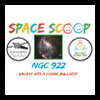CXC Home | Search | Help | Image Use Policy | Latest Images | Privacy | Accessibility | Glossary | Q&A
Tour of NGC 922
Quicktime MPEG
In this holiday season of home cooking and carefully-honed recipes, some astronomers are asking: what is the best mix of ingredients for stars to make the largest number of plump black holes? They are tackling this problem by studying the number of black holes in galaxies with different compositions. One of these galaxies is the ring galaxy NGC 922 that was formed by the collision between two galaxies. This collision triggered the formation of new stars in the shape of a ring. Some of these were massive stars that evolved and collapsed to form black holes. Seven of the sources seen in the Chandra image are thought to contain stellar-mass black holes that are at least ten times more massive than the sun, which places them in the upper range for this class of black hole. By comparing NGC 922 to galaxies with different mixtures of elements, astronomers hope to master the ideal recipe for what it takes to make these large black holes.
[Runtime: 01:09]
Quicktime MPEG
In this holiday season of home cooking and carefully-honed recipes, some astronomers are asking: what is the best mix of ingredients for stars to make the largest number of plump black holes? They are tackling this problem by studying the number of black holes in galaxies with different compositions. One of these galaxies is the ring galaxy NGC 922 that was formed by the collision between two galaxies. This collision triggered the formation of new stars in the shape of a ring. Some of these were massive stars that evolved and collapsed to form black holes. Seven of the sources seen in the Chandra image are thought to contain stellar-mass black holes that are at least ten times more massive than the sun, which places them in the upper range for this class of black hole. By comparing NGC 922 to galaxies with different mixtures of elements, astronomers hope to master the ideal recipe for what it takes to make these large black holes.
[Runtime: 01:09]
(Credit: NASA/CXC/A. Hobart)
Galaxy Hits a Cosmic Bullseye
Quicktime MPEG
The Universe is vast and largely made up of empty space, but cosmic collisions still happen pretty often. Take the galaxy in this picture: it looks like a giant target board, and some 300 million years ago, a smaller galaxy scored a cosmic bullseye when it crashed right into the center of it.
This galaxy began its life as a spiral galaxy. It had several long winding 'arms' of stars and dust wrapped around its center, like the galaxy in this picture . But the impact of the smaller galaxy disturbed the tidy lanes of stars and the neat galactic center and warped the galaxy into this sloppy ring. You can see that the bright, gassy center of the galaxy has been pushed to one side and the spiral arms have been twisted into a chaotic mess. What is left of one of the spiral arms can be seen extending upwards, out of the top of the galaxy.
The collision also set off a ripple effect, like when you throw a pebble into a still lake. The disturbed gases throughout the galaxy triggered a chain reaction of star formation. Hundreds of enormous new stars were born. You can see these as bright red regions in the image.
[Runtime: 01:39]
Quicktime MPEG
The Universe is vast and largely made up of empty space, but cosmic collisions still happen pretty often. Take the galaxy in this picture: it looks like a giant target board, and some 300 million years ago, a smaller galaxy scored a cosmic bullseye when it crashed right into the center of it.
This galaxy began its life as a spiral galaxy. It had several long winding 'arms' of stars and dust wrapped around its center, like the galaxy in this picture . But the impact of the smaller galaxy disturbed the tidy lanes of stars and the neat galactic center and warped the galaxy into this sloppy ring. You can see that the bright, gassy center of the galaxy has been pushed to one side and the spiral arms have been twisted into a chaotic mess. What is left of one of the spiral arms can be seen extending upwards, out of the top of the galaxy.
The collision also set off a ripple effect, like when you throw a pebble into a still lake. The disturbed gases throughout the galaxy triggered a chain reaction of star formation. Hundreds of enormous new stars were born. You can see these as bright red regions in the image.
[Runtime: 01:39]
(Credit: NASA/CXC/April Jubett)
Return to NGC 922 (December 6, 2012)




